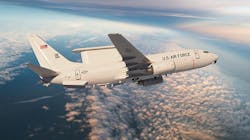Air Force picks Boeing to design future E-7A radar surveillance aircraft for combat air traffic control
HANSCOM AIR FORCE BASE, Mass. – U.S. Air Force aerial surveillance experts are looking to the Boeing Co. to build the E-7A airborne early warning and control (AEW&C) radar aircraft to replace the Air Force fleet of E-3 Sentry Airborne Warning and Control System (AWACS) aircraft.
Officials of the Air Force Life Cycle Management Center at Hanscom Air Force Base, Mass., announced a potential $1.2 billion contract to the Boeing Defense, Space & Security segment in Seattle on 28 Feb. 2023 for the E-7A Rapid Prototype program.
The E-7A will resemble the Australian E-7A Wedgetail aircraft, which is based on the Boeing 737-700ER long-range single-aisle passenger jetliner, and will be for simultaneous air and sea search, as well as combat air traffic control.
The E-7A will have the multi-role electronically scanned array (MESA) radar from the Northrop Grumman Corp. Electronic Systems segment in Linthicum, Md. The surveillance radar will look like a dorsal fin on top of the fuselage. Called top hat, the radar and is designed for minimal aerodynamic effect, and will be able to detect and monitor airborne objects as far away as 400 miles with look-up capability.
The dorsal-fin-like top hat radar will replace the E-3 Sentry AWACS radar system, which looks like a Frisbee flying disk mounted to the top of the plane's fuselage. The old E-3 is based on the Boeing 707 jetliner, which has been in service since the 1950s.
The E-7A aircraft's radar antenna will double as an electronic intelligence (ELINT) array, which can monitor RF signals as far away as 500 miles when the plane is flying at 30,000 feet altitude. The E-7A's radar signal processing and computers will be installed below the antenna array. The E-7A's cabin will have eight operator consoles with sufficient space for four more, if and when needed.
"The E-7A will be the department's principal airborne sensor for detecting, identifying, tracking, and reporting all airborne activity to Joint Force commanders," says Andrew Hunter, assistant secretary of the Air Force for Acquisition, Technology, and Logistics.
"The E-7A will enable greater airborne battlespace awareness through its precise, real-time air picture and will be able to control and direct individual aircraft under a wide range of environmental and operational conditions," Hunter said in an Air Force statement.
Related: Enterprise Air Surveillance Radar tracks first targets at Wallops Island
The Air Force is set to begin E-7A production in 2025, with the first E-7A to be fielded in 2027. Air Force leaders say they expect to buy 26 E-7As by 2032.
The E-7A will have a cabin crew of six to ten, with two pilots in the cockpit. The plane will be 100 feet long, with a 117-foot wingspan, and weigh 43,720 pounds. It will be 41 feet high, cruise at 530 miles per hour, have a 4,000-mile range, and will fly as high as 41,000 feet.
On this contract Boeing will do the work in Seattle, and should be finished by August 2024. For more information contact Boeing Defense, Space & Security online at www.boeing.com/company/about-bds, or the Air Force Life Cycle Management Center at www.aflcmc.af.mil.
